Getting started in the world of firearms can be overwhelming. Sure, there are countless videos, blogs, and books out there, but there are also a lot of conflicting opinions, and sadly, a great deal of misinformation. As someone who aspires to become a more proficient pistol shooter, it was tough to find a reliable source to learn from. Fortunately, I was advised to check out Modern Samurai Project (MSP), a business with a world-class lead instructor who prides himself in getting shooters who are new to red-dot-equipped pistols up to speed quickly. And, as fortune would have it, MSP founder and lead instructor Scott Jedlinski was headed to the nearby Richmond Rod and Gun Club to teach his flagship class: Red Dot Pistol Fundamentals and Performance.
When I first signed up for Scott's 2-day class, I wasn’t entirely sure what to expect. My experience with handguns was limited to rudimentary training with a standard-issue 9mm Beretta during my military service and occasional range visits with my personal handguns. Formal performance training was foreign to me, and the idea of mastering a red dot-equipped pistol in two days felt daunting. However, I was eager to learn, and Scott’s reputation in the industry made this an opportunity I couldn’t pass up.
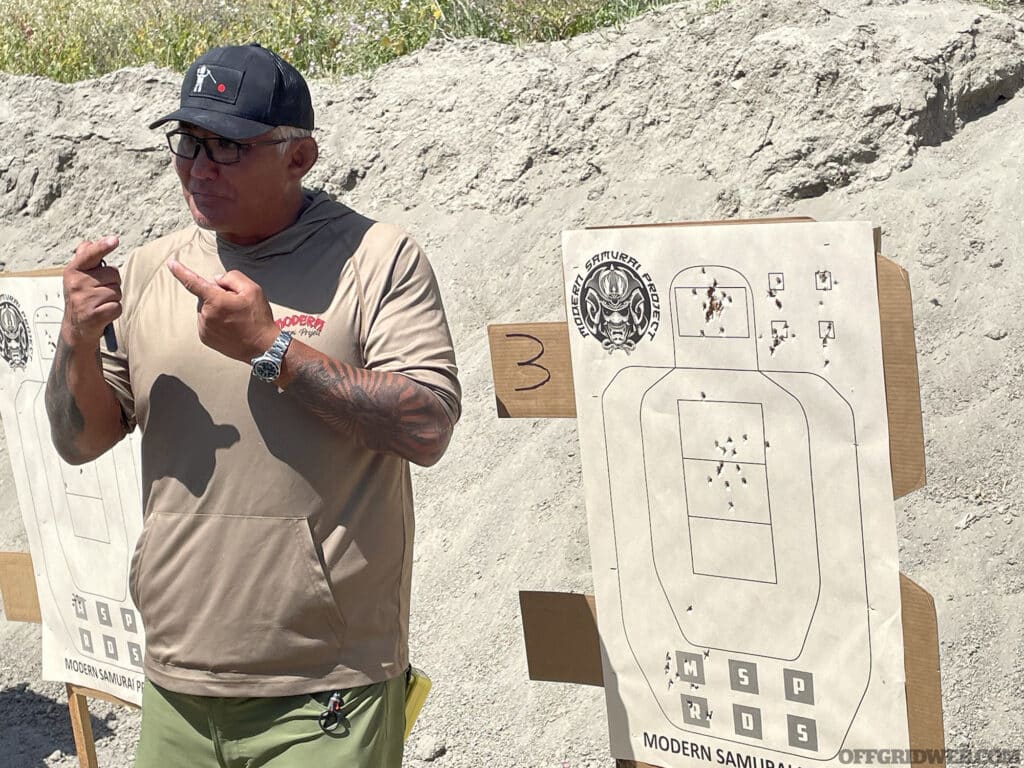
Above: Scott Jedlinski, AKA “Jedi”, applies the discipline he acquired learning martial arts to his passion for performance shooting.
The Instructors
Scott Jedlinski, the mastermind behind this course, is a force to be reckoned with in the world of tactical training. A lifelong martial artist with a Master class shooter rating in USPSA, Scott brings a wealth of experience to the table. With hundreds of hours of training under some of the industry’s best, his expertise spans from self-defense to competition shooting. His Brazilian Jiu-Jitsu brown belt, earned under Tony Passos and Vicente da Silva Jr., adds another layer of discipline to his teaching approach. Scott’s resume isn’t just for show — his classes have been sought after by elite organizations including Pentagon ERT, US Marshals, FBI National Tactical Training Unit, and multiple SWAT teams across the country. His primary focus in this course was on the red dot-equipped pistol, an increasingly ubiquitous tool for carry weapons.
This course was elevated further by assistant instructor AJ Zito of Practical Performance. AJ also has Master class shooter rating with the USPSA, is a U.S. Army combat veteran, and spent several years working in the private security and executive protection sector. Over the years, he has turned his passion for firearms into a career, first earning a gunsmithing degree, and later founding his own instruction company. For more on Zito's background, check out Recoil's interview with him in Issue 67.
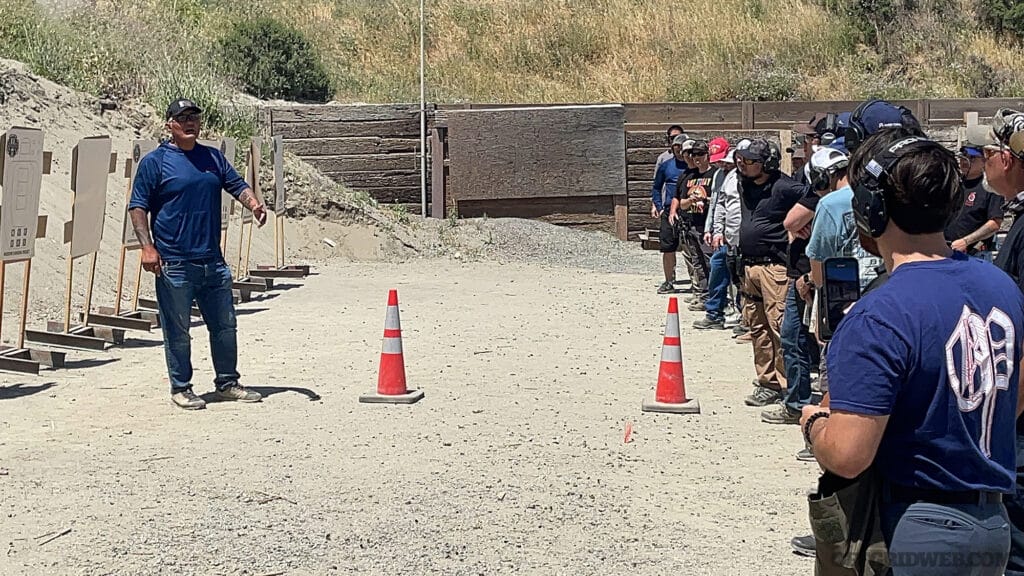
Above: The course was intense and fast paced, but Scott and AJ were always willing to take the time to help students get the techniques right.
The Course: Red Dot Pistol Fundamentals and Performance
This course wasn’t designed for beginners who had never handled a handgun before. To participate, a solid basic pistol skill base is required, which attracted a diverse group of participants, from professional shooters, to law enforcement officers, to guys like myself, all looking to refine their skills with red dot-equipped pistols. The course covered a broad spectrum of topics, from zeroing the red dot to mastering draw techniques and utilizing the sight for accurate shots at various distances.
Scott’s teaching style was straightforward and practical. “This is a way to do it, not the only way to do it,” he reminded us throughout the course. This approach was refreshing and set the tone for an open-minded learning environment.
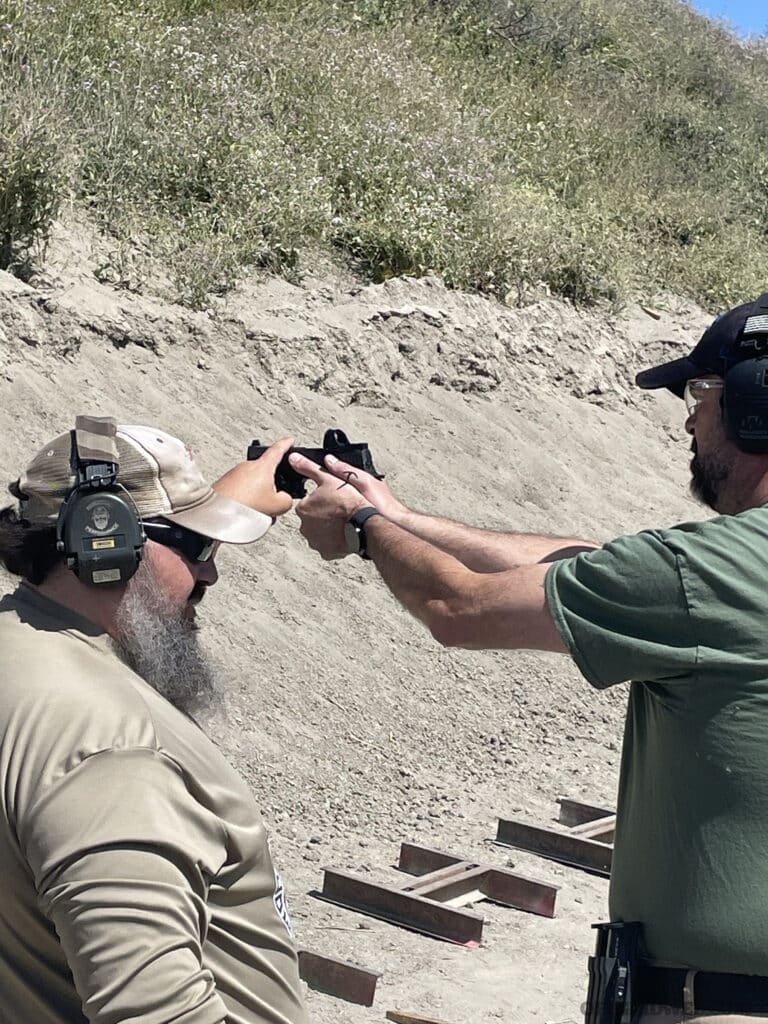
Above: AJ demonstrates how much more stable it is to fire when your elbows are NOT locked out.
Day One: Building the Foundation
The first day kicked off with a focus on the fundamentals. Before even hitting the range, Scott discussed which red dots were available on the market, and which ones he prefers. After a range safety brief, we started by zeroing our red dots. From there, we moved into dry and live fire drills, honing in on grip, stance, and presentation. Scott’s emphasis on maintaining a fighting stance with our feet, and bending rather than locking elbows, ensured that we were shooting from a solid base, which would improve accuracy. He also shared a tip that has since become a staple in my practice: when drawing the firearm, push it down into the holster first, allowing it to “bounce” up into your grip. This technique, combined with learning to build my grip efficiently, drastically improved my draw speed.
We quickly learned that our support hand — rather than the firing hand — is almost 100% responsible for keeping the firearm steady while shooting. Scott pushed us to keep our support hand strong, his exact words being, “don’t let your support hand be a bitch.” It was blunt and humorous, yet an effective reminder that control is key in landing accurate and precise shots. To prove his point, Scott held his firearm primarily with his support hand, not even holding the grip with his firing hand, and with a single finger in the trigger well, sent a burst of rounds into a target in rapid succession. The results were eye-opening. With the gun held firmly with the support hand, it hardly moved.
One of the standout moments from day one was the realization that the red dot isn’t just a tool for precision — the housing itself is a guide that can be used even in high-pressure situations. Scott demonstrated how, in a pinch, simply using the outline of the sight window could be enough to land accurate shots. It was yet another eye opener for me, shifting my perspective on how to utilize the red dot in real-world scenarios. Rather than wasting time acquiring a perfect sight picture in a high-stress, close-range situation, the sight window offers an expeditious way to get shots on target.
At the end of the day, I realized that the way I was wearing my holster didn't seem ideal. When asked how to tweak my setup, Scott offered me some invaluable pointers on concealed appendix carry. For starters, adjusting my belt to move the buckle off-center, and applying custom foam wedges to the back side of the holster to improve the angle and comfort — these were small adjustments that made a big difference.
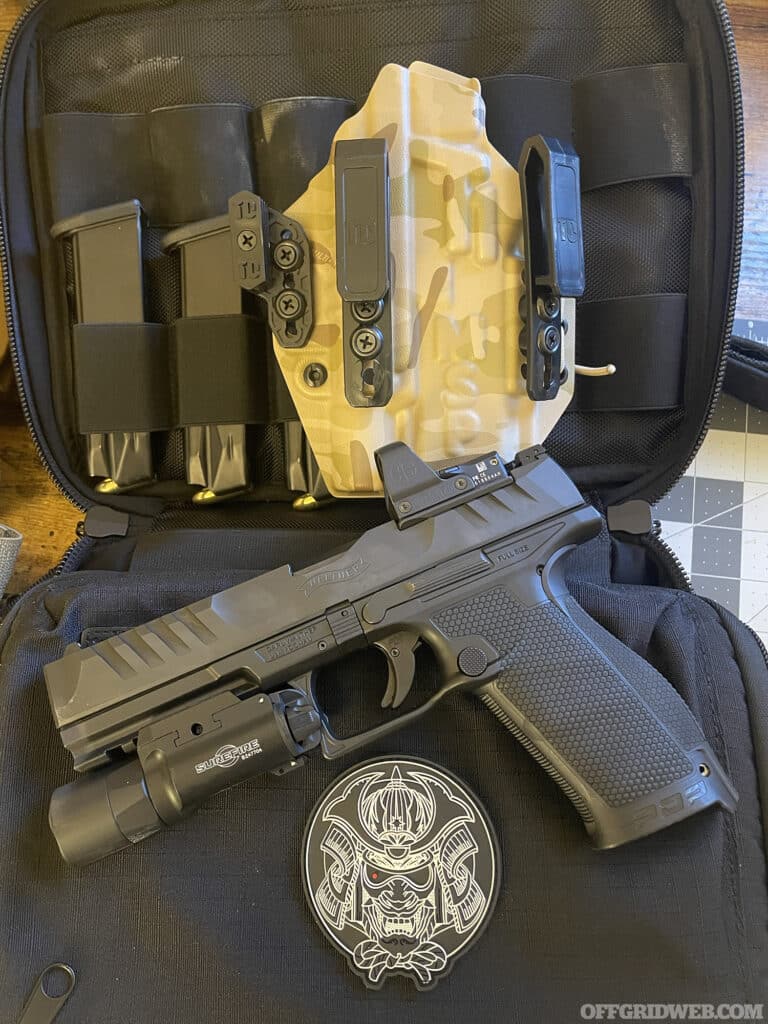
Above: My setup for the class was a Walther PDP, Leupold DeltaPoint Pro, Surefire X300 Turbo, and a Tier 1 Concealed MSP IWB holster (Scott's signature series holster).
Day Two: Pushing the Limits
The second day was all about speed and accuracy. We began shooting at different distances, running through a series of drills designed to push our limits. Scott emphasized the importance of efficiency in our draw and presentation, encouraging us to find a rhythm that allowed for both speed and precision.
Scott’s focus on the support hand was a recurring theme throughout the course. He taught us to drive our pinky finger on the support hand into our sternum, creating a firmer, more stable grip. This small adjustment had a profound impact on my shooting, increasing my control and accuracy significantly.
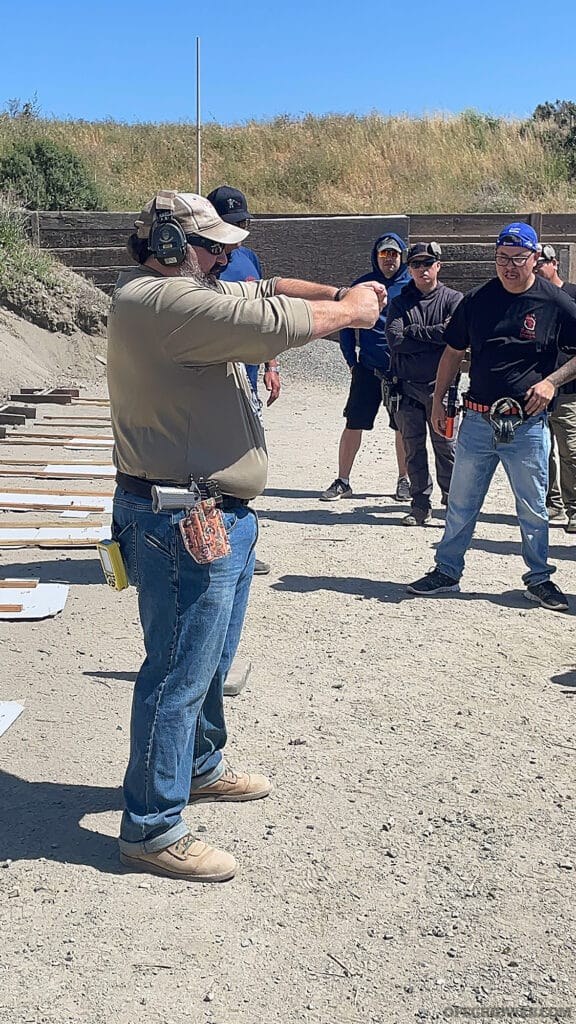
Above: AJ discusses draw technique.
The Black Belt Patch Challenge
One of the unique aspects of this course was the opportunity to earn the Black Belt Patch, a badge of honor that only a few could claim. The criteria were rigorous, to say the least:
- 3&2 Drill: At 3 yards, 3 shots to the center of mass (COM) Alpha, then transition to 2 rounds on a 3×5 card in the head box within 2.0 seconds.
- 1 Shot Drill at 7 yards: 1 shot to COM Alpha within 1.0 second.
- Bill Drill at 7 yards: 6 shots to COM Alpha within 2.0 seconds.
- 1 Shot Drill at 25 yards: 1 shot to COM Alpha within 1.5 seconds.
These drills were not just a test of skill but of composure under pressure. Most of my shots were fired between the 3 and 4 second range, but all were inside the designated target zone. Not too shabby considering this was my first go at any form of competitive shooting challenge, but not enough for that coveted Black Belt Patch. While I still have a long ways to go before I can earn a patch, the challenge provided a clear benchmark for where I stood and what I needed to work on.
Our class did have one Black Belt Patch recipient, and it was none other than assistant instructor AJ Zito. This was the second time for him to earn this difficult achievement, and it spoke to his talents and proficiency as shooter. At MSP classes, even the instructors themselves are continuously putting in hard work to become better shooters — the process of self-improvement is never truly finished.
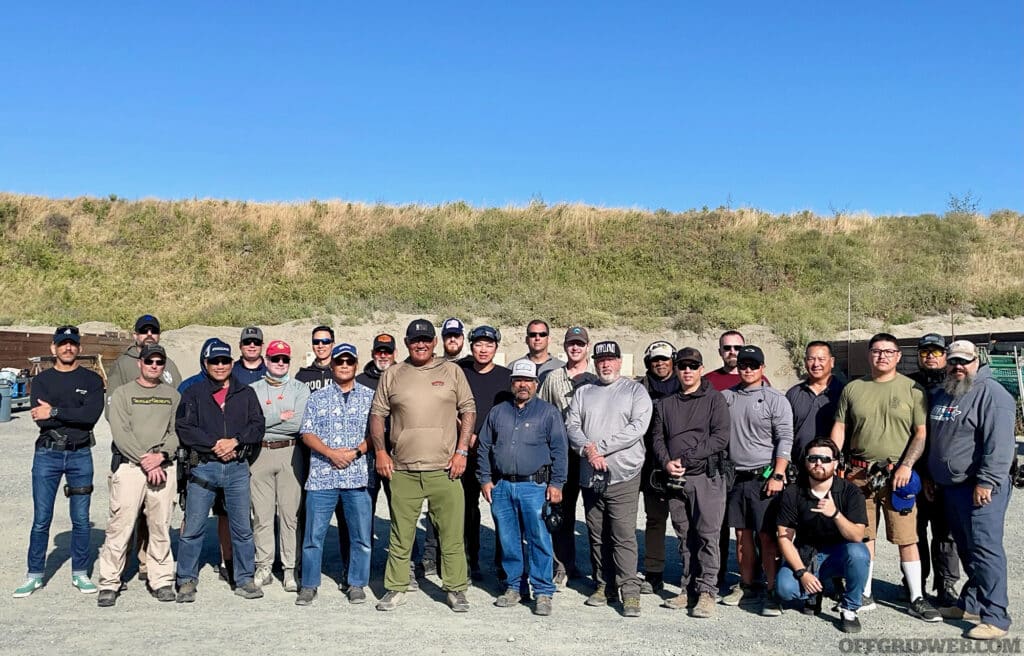
Final Thoughts
Attending Scott’s Red Dot Pistol Fundamentals and Performance course was a paradigm shifting experience. It pushed me to rethink how I approach shooting and highlighted areas where I needed to improve. The biggest takeaway for me was the importance of the support grip, something I had previously thought nothing about. Scott’s teaching style was candid and effective. His ability to break down complex concepts into digestible pieces made the course accessible, even for a relative handgun beginner like me. His emphasis on flexibility, reminding us that there isn’t always a single “right” way to do things, encouraged a mindset of continuous learning and adaptation.
Scott's course is not just a class for one type of shooter — it’s for anyone serious about improving their skills with a red dot-equipped pistol. This course offers valuable insights and practical techniques that can make all the difference in high-pressure situations, whether that's competition, self-defense, or in the line of duty. While the Black Belt Patch remains a goal for the future, the lessons I’ve taken away from this experience are ones that will stick with me and revamp they way I approach training. My future days at the range will be much more effective. If you’re considering taking your shooting skills to the next level, this course is an investment worth making.
Read More
Subscribe to Recoil Offgrid's free newsletter for more content like this.
The post Red Dot Pistol Fundamentals with Modern Samurai Project appeared first on RECOIL OFFGRID.
By: Patrick Diedrich
Title: Red Dot Pistol Fundamentals with Modern Samurai Project
Sourced From: www.offgridweb.com/preparation/red-dot-pistol-fundamentals-with-modern-samurai-project/
Published Date: Mon, 26 Aug 2024 23:48:14 +0000
------------------------
 What is BushcraftSurvival SkillsToolsVideosBushcraft CampsBushcraft KitsBushcraft ProjectsPrivacy PolicyTerms And Conditions
What is BushcraftSurvival SkillsToolsVideosBushcraft CampsBushcraft KitsBushcraft ProjectsPrivacy PolicyTerms And Conditions
